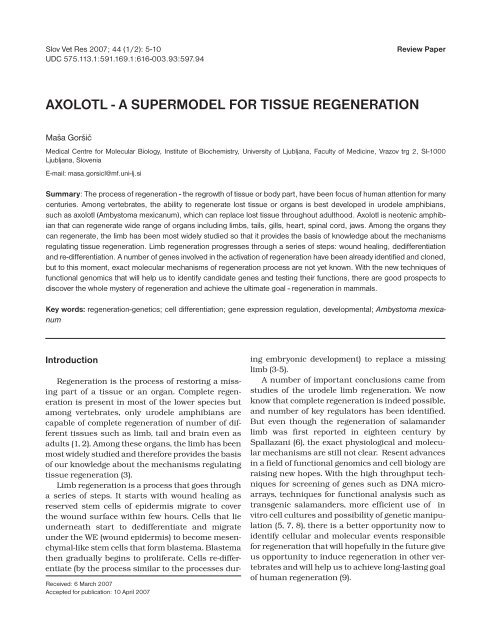Slov Vet Res 2007; 44 (1/2) - Slovenian veterinary research
Slov Vet Res 2007; 44 (1/2) - Slovenian veterinary research
Slov Vet Res 2007; 44 (1/2) - Slovenian veterinary research
Create successful ePaper yourself
Turn your PDF publications into a flip-book with our unique Google optimized e-Paper software.
<strong>Slov</strong> <strong>Vet</strong> <strong>Res</strong> <strong>2007</strong>; <strong>44</strong> (1/2): 5-10<br />
UDC 575.113.1:591.169.1:616-003.93:597.94<br />
Review Paper<br />
AXOLOTL - A SUPERMODEL FOR TISSUE REGENERATION<br />
Maša Goršič<br />
Medical Centre for Molecular Biology, Institute of Biochemistry, University of Ljubljana, Faculty of Medicine, Vrazov trg 2, SI-1000<br />
Ljubljana, <strong>Slov</strong>enia<br />
E-mail: masa.gorsicl@mf.uni-lj.si<br />
Summary: The process of regeneration - the regrowth of tissue or body part, have been focus of human attention for many<br />
centuries. Among vertebrates, the ability to regenerate lost tissue or organs is best developed in urodele amphibians,<br />
such as axolotl (Ambystoma mexicanum), which can replace lost tissue throughout adulthood. Axolotl is neotenic amphibian<br />
that can regenerate wide range of organs including limbs, tails, gills, heart, spinal cord, jaws. Among the organs they<br />
can regenerate, the limb has been most widely studied so that it provides the basis of knowledge about the mechanisms<br />
regulating tissue regeneration. Limb regeneration progresses through a series of steps: wound healing, dedifferentiation<br />
and re-differentiation. A number of genes involved in the activation of regeneration have been already identified and cloned,<br />
but to this moment, exact molecular mechanisms of regeneration process are not yet known. With the new techniques of<br />
functional genomics that will help us to identify candidate genes and testing their functions, there are good prospects to<br />
discover the whole mystery of regeneration and achieve the ultimate goal - regeneration in mammals.<br />
Key words: regeneration-genetics; cell differentiation; gene expression regulation, developmental; Ambystoma mexicanum<br />
Introduction<br />
Regeneration is the process of restoring a missing<br />
part of a tissue or an organ. Complete regeneration<br />
is present in most of the lower species but<br />
among vertebrates, only urodele amphibians are<br />
capable of complete regeneration of number of different<br />
tissues such as limb, tail and brain even as<br />
adults (1, 2). Among these organs, the limb has been<br />
most widely studied and therefore provides the basis<br />
of our knowledge about the mechanisms regulating<br />
tissue regeneration (3).<br />
Limb regeneration is a process that goes through<br />
a series of steps. It starts with wound healing as<br />
reserved stem cells of epidermis migrate to cover<br />
the wound surface within few hours. Cells that lie<br />
underneath start to dedifferentiate and migrate<br />
under the WE (wound epidermis) to become mesenchymal-like<br />
stem cells that form blastema. Blastema<br />
then gradually begins to proliferate. Cells re-differentiate<br />
(by the process similar to the processes dur-<br />
Received: 6 March <strong>2007</strong><br />
Accepted for publication: 10 April <strong>2007</strong><br />
ing embryonic development) to replace a missing<br />
limb (3-5).<br />
A number of important conclusions came from<br />
studies of the urodele limb regeneration. We now<br />
know that complete regeneration is indeed possible,<br />
and number of key regulators has been identified.<br />
But even though the regeneration of salamander<br />
limb was first reported in eighteen century by<br />
Spallazani (6), the exact physiological and molecular<br />
mechanisms are still not clear. <strong>Res</strong>ent advances<br />
in a field of functional genomics and cell biology are<br />
raising new hopes. With the high throughput techniques<br />
for screening of genes such as DNA microarrays,<br />
techniques for functional analysis such as<br />
transgenic salamanders, more efficient use of in<br />
vitro cell cultures and possibility of genetic manipulation<br />
(5, 7, 8), there is a better opportunity now to<br />
identify cellular and molecular events responsible<br />
for regeneration that will hopefully in the future give<br />
us opportunity to induce regeneration in other vertebrates<br />
and will help us to achieve long-lasting goal<br />
of human regeneration (9).
















